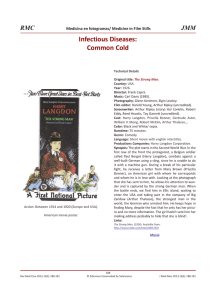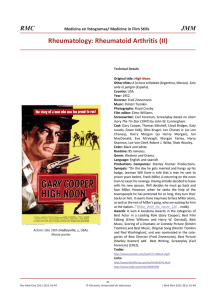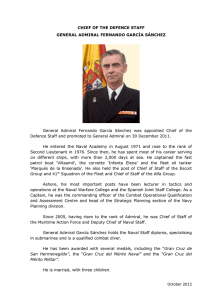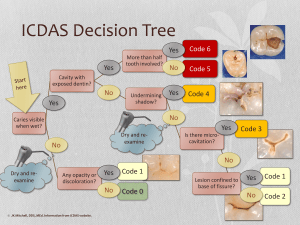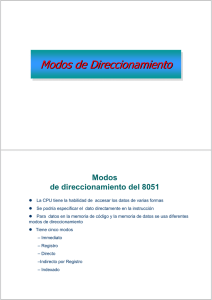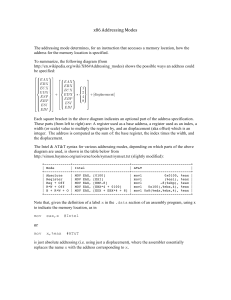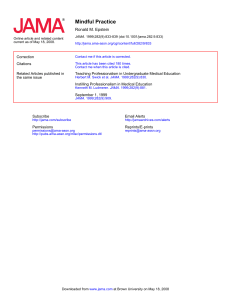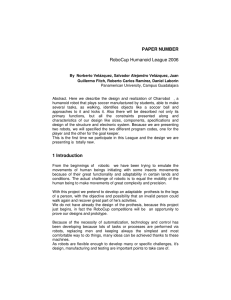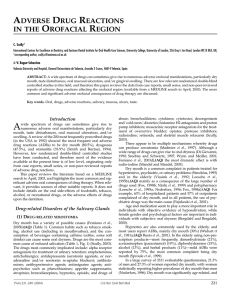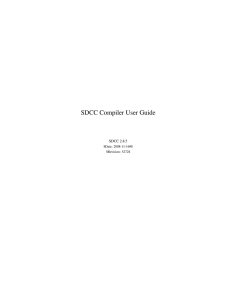The Journal of Medicine and Movies and the Medical Education
Anuncio
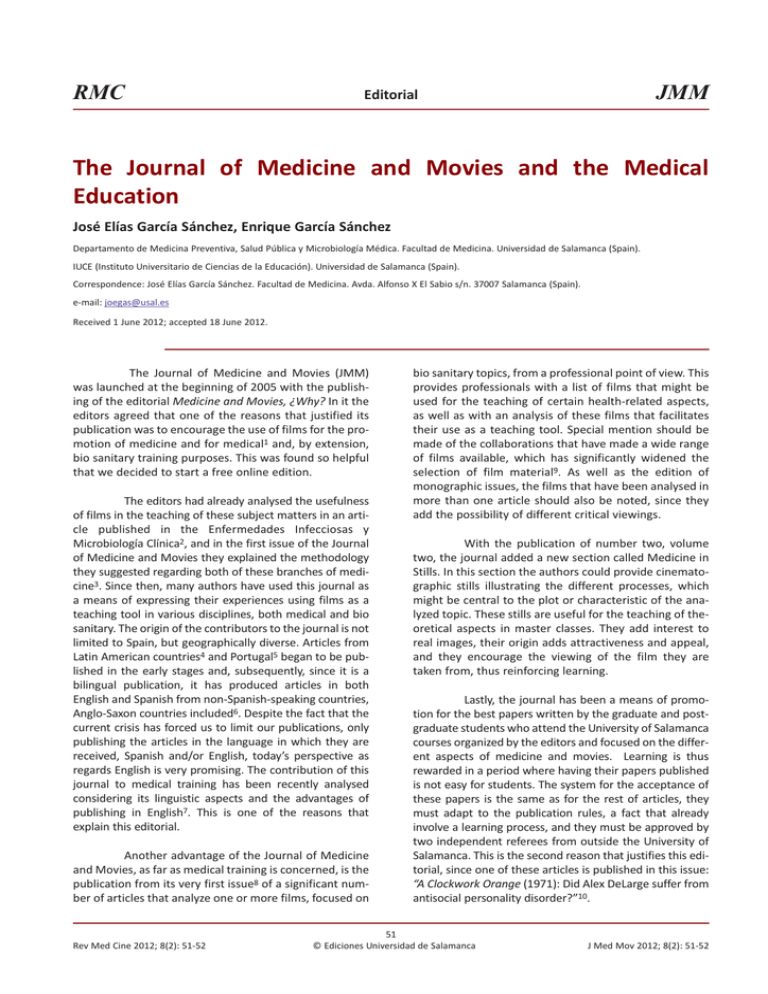
RMC JMM Editorial The Journal of Medicine and Movies and the Medical Education José Elías García Sánchez, Enrique García Sánchez Departamento de Medicina Preventiva, Salud Pública y Microbiología Médica. Facultad de Medicina. Universidad de Salamanca (Spain). IUCE (Instituto Universitario de Ciencias de la Educación). Universidad de Salamanca (Spain). Correspondence: José Elías García Sánchez. Facultad de Medicina. Avda. Alfonso X El Sabio s/n. 37007 Salamanca (Spain). e-mail: joegas@usal.es Received 1 June 2012; accepted 18 June 2012. The Journal of Medicine and Movies (JMM) was launched at the beginning of 2005 with the publishing of the editorial Medicine and Movies, ¿Why? In it the editors agreed that one of the reasons that justified its publication was to encourage the use of films for the promotion of medicine and for medical1 and, by extension, bio sanitary training purposes. This was found so helpful that we decided to start a free online edition. The editors had already analysed the usefulness of films in the teaching of these subject matters in an article published in the Enfermedades Infecciosas y Microbiología Clínica2, and in the first issue of the Journal of Medicine and Movies they explained the methodology they suggested regarding both of these branches of medicine3. Since then, many authors have used this journal as a means of expressing their experiences using films as a teaching tool in various disciplines, both medical and bio sanitary. The origin of the contributors to the journal is not limited to Spain, but geographically diverse. Articles from Latin American countries4 and Portugal5 began to be published in the early stages and, subsequently, since it is a bilingual publication, it has produced articles in both English and Spanish from non-Spanish-speaking countries, Anglo-Saxon countries included6. Despite the fact that the current crisis has forced us to limit our publications, only publishing the articles in the language in which they are received, Spanish and/or English, today’s perspective as regards English is very promising. The contribution of this journal to medical training has been recently analysed considering its linguistic aspects and the advantages of publishing in English7. This is one of the reasons that explain this editorial. Another advantage of the Journal of Medicine and Movies, as far as medical training is concerned, is the publication from its very first issue8 of a significant number of articles that analyze one or more films, focused on Rev Med Cine 2012; 8(2): 51-52 bio sanitary topics, from a professional point of view. This provides professionals with a list of films that might be used for the teaching of certain health-related aspects, as well as with an analysis of these films that facilitates their use as a teaching tool. Special mention should be made of the collaborations that have made a wide range of films available, which has significantly widened the selection of film material9. As well as the edition of monographic issues, the films that have been analysed in more than one article should also be noted, since they add the possibility of different critical viewings. With the publication of number two, volume two, the journal added a new section called Medicine in Stills. In this section the authors could provide cinematographic stills illustrating the different processes, which might be central to the plot or characteristic of the analyzed topic. These stills are useful for the teaching of theoretical aspects in master classes. They add interest to real images, their origin adds attractiveness and appeal, and they encourage the viewing of the film they are taken from, thus reinforcing learning. Lastly, the journal has been a means of promotion for the best papers written by the graduate and postgraduate students who attend the University of Salamanca courses organized by the editors and focused on the different aspects of medicine and movies. Learning is thus rewarded in a period where having their papers published is not easy for students. The system for the acceptance of these papers is the same as for the rest of articles, they must adapt to the publication rules, a fact that already involve a learning process, and they must be approved by two independent referees from outside the University of Salamanca. This is the second reason that justifies this editorial, since one of these articles is published in this issue: “A Clockwork Orange (1971): Did Alex DeLarge suffer from antisocial personality disorder?”10. 51 © Ediciones Universidad de Salamanca J Med Mov 2012; 8(2): 51-52 JE García Sánchez, E García Sánchez The Journal of Medicine and Movies and the Medical Education The impact of this journal is clearly greater if the articles from Spanish-speaking countries are also published in English, and that is why we encourage our contributors to send their articles in both languages if possible. References 1. García Sánchez JE, Trujillano Martín I, García Sánchez E. Medicine and Cinema, Why? J Med Mov [Internet]. 2005; 1(1): 1-2. Available from: http://revistamedicinacine.usal.es/index.php/en/vol1/num1/127 2. García Sánchez JE, Fresnadillo Martínez MJ, García Sánchez E. El cine en la docencia de las enfermedades infecciosas y la microbiología clínica. Enferm Infecc Microbiol Clin. 2002; 20: 403-406. Available from: http://apps.elsevier.es/watermark/ctl_servlet?_f=10&pident_articulo=13037009& pident_usuario=0&pcontactid=&pident_revista=28&ty=140&accion=L&origen=els evier&web=www.elsevier.es&lan=es&fichero=28v20n08a13037009pdf001.pdf 3. Fresnadillo Martínez MJ, Diego Amado C, García Sánchez E, García Sánchez JE. Teaching methodology for the utilization of cinema in the teaching of medical microbiology and infectious diseases. J Med Mov [Internet]. 2005; 1(1): 17-23. Available from: http://revistamedicinacine.usal.es/index.php/en/vol1/num1/26 Rev Med Cine 2012; 8(2): 51-52 4. Bottasso O. The Traviata in the movie of Zeffirelli. A history of tuberculosis and other ailments. J Med Mov [Internet]. 2005; 1(3): 60-65. Available from: http://revistamedicinacine.usal.es/index.php/en/vol1/num3/142 5. Pais de Lacerda A. Medical Education: Addiction and the Cinema (Drugs and gambling as a search for happiness). J Med Mov [Internet]. 2005; 1(4): 95-102. Available from: http://revistamedicinacine.usal.es/index.php/en/vol1/num4/148 6. Darbyshire D, Baker P. Cinema in Medical Education – Has it Penetrated the Mainstream? J Med Mov [internet]. 2010;7(1):8-14. Available from: http://revistamedicinacine.usal.es/index.php/en/vol7/num1/624 7. Darbyshire D, Baker P. A systematic review and thematic analysis of cinema in medical education. Med Humanit. 2012;38 (1):28-33. 8. Aijón Oliva J, Salazar Alonso-Villalobos V. Lorenzo's Oil (1992): Cinematographic overview. J Med Mov [Internet]. 2005; 1(1): 3-6. Available from: http://revistamedicinacine.usal.es/index.php/en/vol1/num1/17 9. Merino Marcos ML. Cerebral palsy in the cinema. J Med Mov [Internet]. 2005; 1(3): 6676. Available from: http://revistamedicinacine.usal.es/index.php/en/vol1/num3/144 10. Lorenzo L. La naranja mecánica (1971): ¿padecía Alex DeLarge un trastorno antisocial de la personalidad? Rev Med Cine [Internet]. 2012; 8(2): 53-58. Available from: http://revistamedicinacine.usal.es/index.php/es/vol8/num2/679 52 © Ediciones Universidad de Salamanca J Med Mov 2012; 8(2): 51-52
